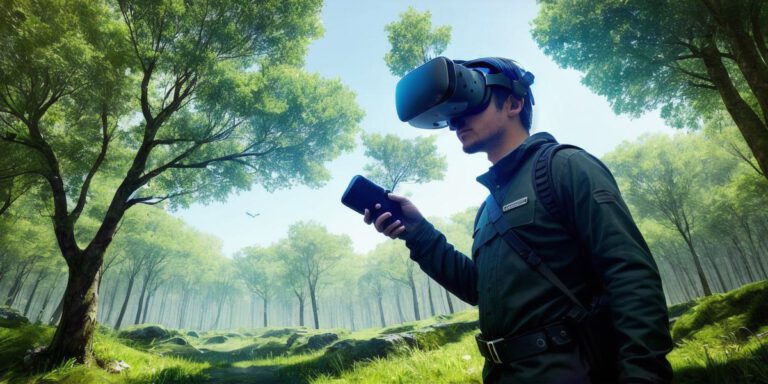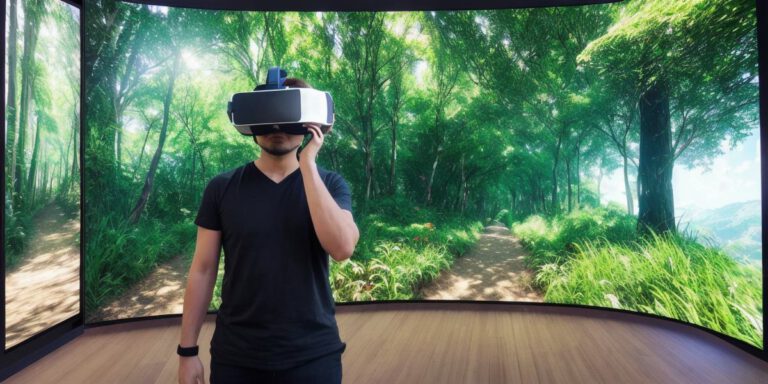Pros and Cons of 2D vs 3D Virtual Reality: A Comprehensive Guide for Developers

Virtual reality (VR) technology has come a long way since its inception, and today it is being used in various industries such as gaming, education, healthcare, and more. While there are different types of VR systems available, two of the most popular ones are 2D and 3D virtual reality. In this article, we will explore the pros and cons of using 2D versus 3D VR for developers, including case studies and personal experiences to help you make an informed decision about which type of VR technology to use in your project.
Understanding the Basics: What is 2D VR?
Two-dimensional virtual reality (2D VR) is a type of VR system where the user’s view is projected on a flat screen, and they can interact with virtual objects using handheld controllers or other input devices. This type of VR is typically used for gaming or educational purposes, where the goal is to create an immersive experience that simulates real-world environments.
Pros and Cons of 2D VR
Pros:
- Cost-effective: 2D VR systems are generally less expensive than 3D VR systems, making them a more affordable option for small businesses or startups.
- Easier to develop: Developing a 2D VR experience is typically easier and faster than developing a 3D VR experience, as there are fewer technical requirements to consider.
- Wide range of applications: 2D VR can be used in a variety of industries, including gaming, education, training, and more.
Cons:
- Limited immersion: 2D VR provides a limited level of immersion compared to 3D VR, as the user is not able to physically move within the virtual environment.
- Lack of interaction: While handheld controllers can provide some interaction, they are not as intuitive or responsive as more advanced input devices such as gloves or haptic feedback systems.
- Limited creativity: 2D VR experiences are limited by the flat screen display, which can make it challenging to create truly immersive and interactive environments.
Understanding the Basics: What is 3D VR?
Three-dimensional virtual reality (3D VR) is a type of VR system where the user’s view is projected on a headset, and they can physically move within the virtual environment using specialized motion tracking devices. This type of VR is typically used for gaming, education, healthcare, and other industries that require a high level of immersion and interaction.
Pros and Cons of 3D VR
Pros:
- High immersion: 3D VR provides a high level of immersion by allowing users to physically move within the virtual environment, making it ideal for applications such as gaming or training.
- Advanced interaction: 3D VR experiences can be enhanced with advanced input devices such as gloves or haptic feedback systems, providing a more intuitive and responsive user experience.
- Increased creativity: With the ability to physically move within the virtual environment, 3D VR allows developers to create truly immersive and interactive experiences that were not possible with 2D VR.
Cons:
- Expensive: 3D VR systems are generally more expensive than 2D VR systems, making them less accessible for small businesses or startups.
- Technical requirements: Developing a 3D VR experience requires specialized technical skills and knowledge, which can make it more challenging for some developers.
- Limited applications: While 3D VR has many potential applications, it may not be suitable for all industries due to the high cost and technical requirements.
Real-Life Examples of 2D vs. 3D VR in Action
2D VR Example: Google Expeditions
Google Expeditions is a free educational app that allows users to explore virtual reality environments from their smartphones or tablets. The app uses 2D VR technology, and users can interact with virtual objects using handheld controllers. While the app provides some level of immersion, it is limited by the flat screen display and does not allow users to physically move within the virtual environment.

3D VR Example: Oculus Quest
The Oculus Quest is a popular 3D VR headset that allows users to explore virtual reality environments from their living rooms. The headset uses advanced motion tracking technology, and users can physically move within the virtual environment using specialized handheld controllers. The Oculus Quest provides a high level of immersion and allows developers to create truly interactive experiences that were not possible with 2D VR.
FAQs
- What is the main difference between 2D vs. 3D VR?
The main difference between 2D vs. 3D VR is the level of immersion and interaction provided to the user. 2D VR provides a limited level of immersion, while 3D VR allows users to physically move within the virtual environment and provides advanced interaction capabilities.
- What industries use 2D vs. 3D VR?
2D VR is typically used in gaming or educational purposes, while 3D VR is used in a variety of industries such as gaming, education, healthcare, and more.
- How much does 2D vs. 3D VR cost?
2D VR systems are generally less expensive than 3D VR systems, making them a more affordable option for small businesses or startups. 3D VR systems can be quite expensive due to the specialized technical requirements and advanced input devices.
- What are some real-life examples of 2D vs. 3D VR in action?
Real-life examples of 2D vs. 3D VR include Google Expeditions (2D VR) and the Oculus Quest (3D VR). These examples demonstrate the different levels of immersion and interaction provided by each type of VR technology.








